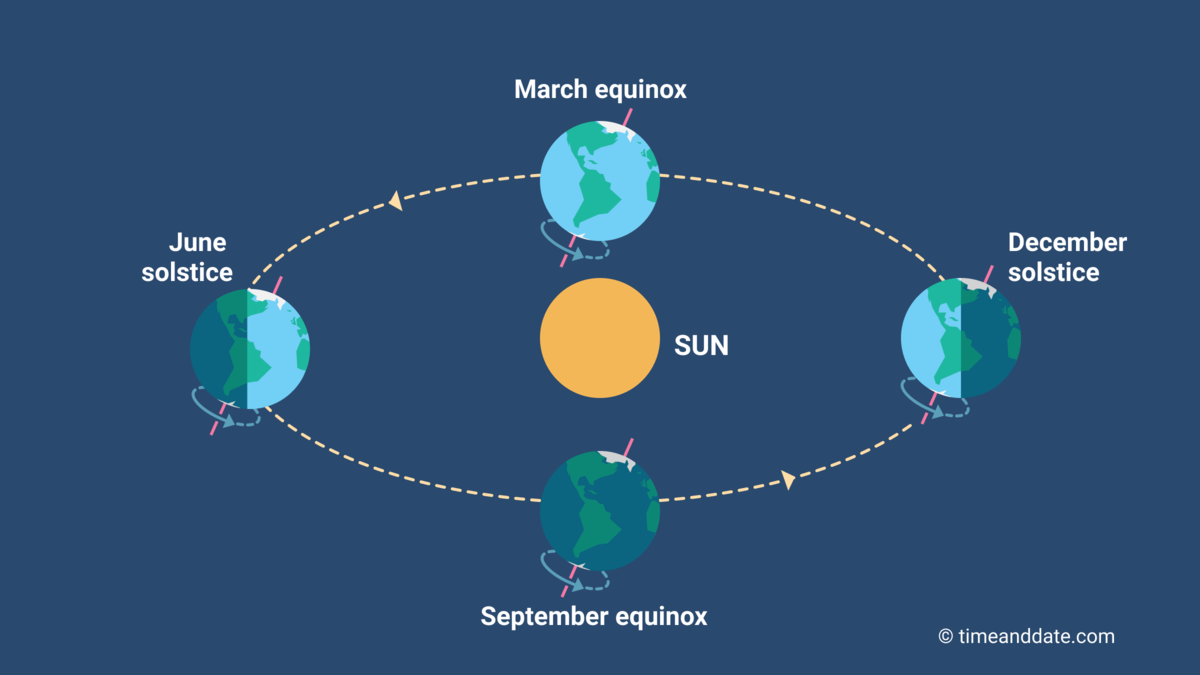December Solstice: Longest and Shortest Day of the Year
There are two solstices every year: one in December and one in June. The December solstice marks the shortest day north of the equator and the longest day in the south.

In December, the North Pole is tilted away from the Sun.
© timeanddate.com
Equal day and night? It happens at the solstice!
Winter solstice: Shortest day, but not the latest sunrise
Sun Reaches Most Southerly Point
The December solstice is the moment the Sun is directly above the Tropic of Capricorn in the Southern Hemisphere. This is the southernmost latitude it reaches during the year. After the solstice, it begins moving north again.
10 facts about the December solstice
Solstice Local Time & Date
In Columbus, Ohio, USA: Sunday, December 21, 2025 at 10:03 am EST (Change location)
This corresponds to Sunday, December 21, 2025 at 15:03 UTC.
Shortest Day in the North
Since the Northern Hemisphere is tilted away from the Sun in December, it receives less sunlight during the course of a day. At the solstice, the North Pole's tilt away from the Sun is greatest, so this event marks the shortest day of the year north of the equator.
This effect is greatest in locations that are farther away from the equator. In tropical areas, the shortest day is just a little shorter than 12 hours; in the temperate zone, it is significantly shorter; and places within the Arctic Circle experience polar night, when the Sun does not rise at all.
Longest Day in the South
Conversely, the day of the December solstice is the longest day of the year in the Southern Hemisphere. Here, too, the effect is greater the farther a location is away from the equator.
Places within the Antarctic Circle experience Midnight Sun, when the Sun does not set at night.
Sun times at the South Pole in December
What Does “Solstice” Mean?
During the course of a year, the subsolar point—the spot on the Earth's surface directly beneath the Sun—slowly moves along a north-south axis. Having reached its northernmost point at the June solstice, it starts moving southward until it crosses the equator on the day of the September equinox. At the December solstice, which marks the southernmost point of its journey, it stops again to start its journey back toward the north.
Why is the solstice so important for calendars?
This is how the solstices got their name: the term comes from the Latin words sol and sistere, meaning “Sun” and “to stand still”.
Initially, the naming arose from observations of how the Sun’s apparent path across the sky changes slightly from one day to the next, which is caused by the same process as the subsolar point's movement described above.
In the months leading up to the December solstice, the position of sunrise and sunset creeps southward. On the day of the solstice, it reaches its southernmost point. After that, the daily path of the Sun across the sky begins to creep northward again.
Why Does the Sun Move North and South?
The subsolar point moves north and south during the year because the Earth’s axis is tilted at an angle of about 23.4° in relation to the ecliptic, an imaginary plane created by Earth’s path around the Sun. In June, the Northern Hemisphere is tilted toward the Sun, and the subsolar point is north of the equator. As the Earth travels toward the opposite side of its orbit, which it reaches in December, the Southern Hemisphere gradually receives more sunlight, and the subsolar point travels south.


Earth is tilted as it orbits the Sun, which is why equinoxes and solstices happen.
©timeanddate.com
The Solstices and the Seasons
The December solstice marks the start of winter in the Northern Hemisphere and the start of summer in the Southern Hemisphere, according to one definition.
Equinox and solstice dates—years 1-2149
Sunrise and Sunset Times Lag Behind
The shortest day of the year is commonly associated with the latest sunrise and earliest sunset of the year. However, in most locations, the earliest sunset happens a few days before the solstice, while the latest sunrise occurs some days after it. Find out why
The December Solstice in the Calendar
The December solstice can be on December 20, 21, 22, or 23.
December 21 or 22 solstices happen more often than December 20 and 23 solstices. The last December 23 solstice was in 1903 and the next one is in 2303. A December 20 solstice is also rare, with the next one in the year 2080.
Note: All dates refer to Coordinated Universal Time (UTC). Local dates may vary depending on the time zone.
Why Does the Date Vary?
The date of the equinoxes and solstices varies because a year in our calendar does not exactly match the length of the tropical year—the time it takes the Earth to complete an orbit around the Sun.
Today's Gregorian calendar has 365 days in a common year and 366 days in a leap year. However, our planet takes about 365.242199 days to orbit the Sun. This means that the timing of the equinoxes and solstices slowly drifts apart from the Gregorian calendar, and the solstice happens about 6 hours later each year. Eventually, the accumulated lag becomes so large that it falls on the following date.
To realign the calendar with the tropical year, a leap day is introduced (nearly) every four years. When this happens, the equinox and solstice dates shift back to the earlier date again.
Other factors influencing the timing of the equinoxes and solstices include variations in the length of a tropical year and in the orbital and daily rotational motion of the Earth, such as the “wobble” in the Earth's axis (precession).
